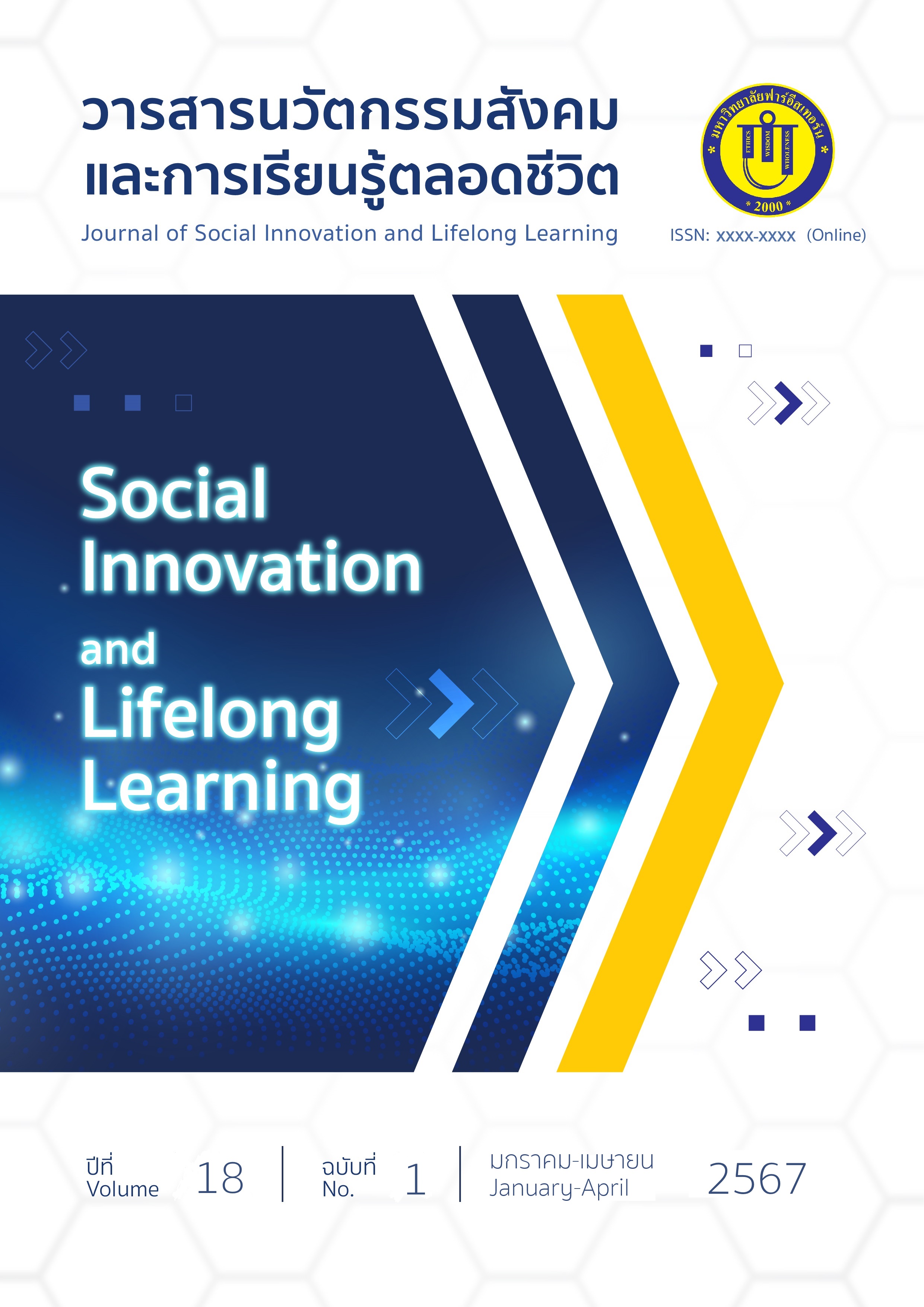Rabam-sor after Princess Dara Rasmi: Analysis of literature characteristic and literary arts
Main Article Content
Abstract
“Rabam-sor Somphot Chang-phueak” is a performance that created by Princess Dara Rasmi for celebrate Phra Sawet Kachadej Dilok - The white elephant, when His Majesty King Prajadhipok visited Monthon Phayap in 1926. After that, there were many people who created performance that resemble the Rabam-sor Somphot Chang-phueak and call them “Rabam-sor”. This article will present the results of the analysis of Rabam-sor after Princess Dara Rasmi in terms of literature characteristic and literary arts. This study collected data from 8 performances “Rabam-sor” that created after Princess Dara Rasmi and Rabam-sor Somphot Chang-phueak. The study is shown that 1) structure form: There are 4 types of structures; The Somphot Chang-phueak style, The Chao Buathip’s style, The style that using the Yonok and Sor Yin, and the style that using Sor Yin only. 2) content: There are 3 topics; honoring individuals, honoring organizational, and celebrating Buddhist activities. 3) prosody: There are uses 3 types of prosody that appears in the Rabam-sor Somphot Chang-phueak but some characteristics were found to be different; terms of the syllables in lines, number of lines, rhyme, and tone marking at the end of lines. 4) Inheriting expressions: There are 2 ways; words at the beginning of the lines and maintaining-and-adapting the original expressions. And last, 5) literary arts: There are uses 3 literary arts; Selecting sounds, selecting words and Using figurative Language. The study reveals the inheritance and resolution of the characteristics of Rabam-sor, which has a part in the field of Lanna literary and performance. It is an extension of the wisdom of Princess Dara Rasmi that responds to the purpose which based on the present context. It still maintains the outstanding characteristics of Lanna literature that expresses respect intellect of the ancestor. Continuing with sophistication beautiful with a unique local language. That is in line with the Princess Dara Rasmi - who created “Rabam-sor” for intention to preserve, expand and spread the uniqueness of the Lanna in a sustainable manner.
Article Details

This work is licensed under a Creative Commons Attribution-NonCommercial-NoDerivatives 4.0 International License.
1. Any views and comments in the Journal of Social Innovation and Lifelong Learning are the authors’ views. The editorial staff have not to agree with those views and it is not considered as the editorial’s responsibility.
2. The responsibility of content and draft check of each article belongs to each author. In case, there is any lawsuit about copyright infringement. It is considered as the authors’ sole responsibility.
3. The article copyright belonging to the authors and The Far Eastern University are copyrighted legally. Republication must be received direct permission from the authors and The Far Eastern University in written form.
References
กมล มโนชญากร. (2474). จดหมายเหตุ เสด็จพระราชดำเนิรเลียบมณฑลฝ่ายเหนือ พระพุทธศักราช 2469. โรงพิมพ์โสภณพิพรรฒธนากร.
ฉัตรยุพา สวัสดิพงษ์. (2559). วรรณกรรมล้านนาคัดสรร : วรรณกรรมพรรณนาอารมณ์. สำนักงานกองทุนสนับสนุนการวิจัย.
ณัฐพงษ์ ปัญจบุรี. (2562). วรรณกรรมในสมัยพระราชชายาเจ้าดารารัศมี. ลานนาการพิมพ์.
ณัฐพงษ์ ปัญจบุรี. (2562). การศึกษาวิเคราะห์คำซ้อนในค่าวซอเรื่องพระอภัยมณีและศรีสุวัณณ์. [รายงานการวิจัย, กองทุนนหาวิทยาลัยราชภัฏเชียงใหม่].
ธเนศ เวศร์ภาดา. (2549). หอมโลกวรรณศิลป์ : การสร้างรสสุนทรีย์แห่งวรรณคดีไทย. ปาเจรา.
ราชบัณฑิตยสถาน. (2540). สารานุกรมศัพท์ดนตรีไทย ภาคคีตะ - ดุริยางค์. ราชบัณฑิตยสถาน.
วินัย พงศ์ศรีเพียร. (2562). รุธิราชรำพัน (โคลงนิราศหริภุญชัยและจารึกวัดพระยืน มรดกความทรงจำแห่งอภินวบุรี-ศรีหริภุญชัย). มูลนิธิสมเด็จพระเทพรัตนราชสุดา.
ศิวาพร วัฒนรัตน์. (2554). วรรณกรรมนิทานคำโคลงของล้านนา : ลักษณะเด่น ภูมิปัญญา และคุณค่า. ธนุชพริ้นติ้ง.
สงกรานต์ สมจันทร์. (2563). ประวัติดนตรีล้านนา. ภาควิชาดนตรีและศิลปะการแสดง คณะมนุษยศาสตร์และสังคมศาสตร์ มหาวิทยาลัยราชภัฏเชียงใหม่.
สาโรจน์ บัวพันธุ์งาม. (2558). เอกสารประกอบการสอน กระบวนวิชา (014211) ภาษาบาลีและสันสกฤตในภาษาไทย. คณะมนุษยศาสตร์ มหาวิทยาลัยเชียงใหม่.
สายสวรรค์ ขยันยิ่ง. (2543). พระราชชายาเจ้าดารารัศมีกับนาฏศิลป์ล้านนา. [วิทยานิพนธ์ปริญญามหาบัณฑิต, จุฬาลงกรณ์มหาวิทยาลัย].
สุจิตรา จงสถิตวัฒนา. (2549). เจิมจันทน์กังสดาล : ภาษาวรรณศิลป์ในวรรณคดีไทย. โครงการเผยแพร่ผลงานวิชาการ คณะอักษรศาสตร์ จุฬาลงกรณ์มหาวิทยาลัย.
หทัยวรรณ ไชยะกุล. (2556). วรรณกรรมล้านนาร่วมสมัย (พ.ศ. 2413-2550) : การสืบทอดภูมิปัญญาและการสร้างสรรค์. นพบุรีการพิมพ์.
อนุมานราชธน, พระยา. (2522). นิรุกติศาสตร์. มูลนิธิเสฐียรโกเศศ-นาคะประทีป.
อุดม รุ่งเรืองศรี. (2549) คร่าวซอเรื่องเจ้าสุทนนางมโนห์รา. โครงการจัดทำเอกสารข้อมูลเพื่อการอนุรักษ์ต้นฉบับและเป็นฐานในการสร้างนักวิชาการด้านล้านนารุ่นใหม่.

